
by Sandra Gulland | May 17, 2013 | Adventures of a Writing Life, The Shadow Queen |
Sometimes a silence builds up like a damn: I’ve so much to report I don’t report anything.
So here goes:
Today I sent my Canadian and U.S. publishers suggestions for the cover art for THE SHADOW QUEEN. (Wow: it’s really happening.)
This took all morning—during which there was an earthquake!—and entailed poking around in my old files.
It was moving opening up a file of the original images I had used for building my characters years ago. I’m in the process of “building” characters for The Next Novel (the Young Adult about Josephine’s daughter Hortense), and it was a pleasant reminder of how helpful it can be to scout out character images on the Net. (I used Morgue File.)
Here is the image I selected for Claude (Claudette), heroine of THE SHADOW QUEEN:

I KNOW: it’s a guy, but something in his look spoke to me of Claude, who is a masculine woman.
And then later I found a Rossetti painting that struck me as Claude at court:
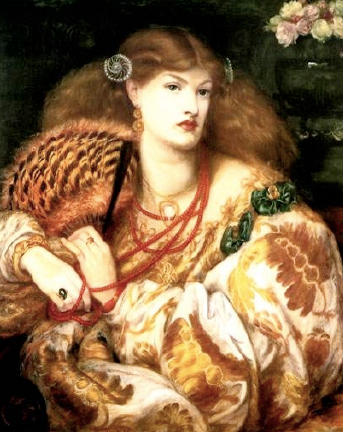
I was shocked to see how much alike these two images were — compare their eyes, eye brows, nose, lips. Amazing.
This Sargent painting is my image of Claude at the end of her life: triumphant!
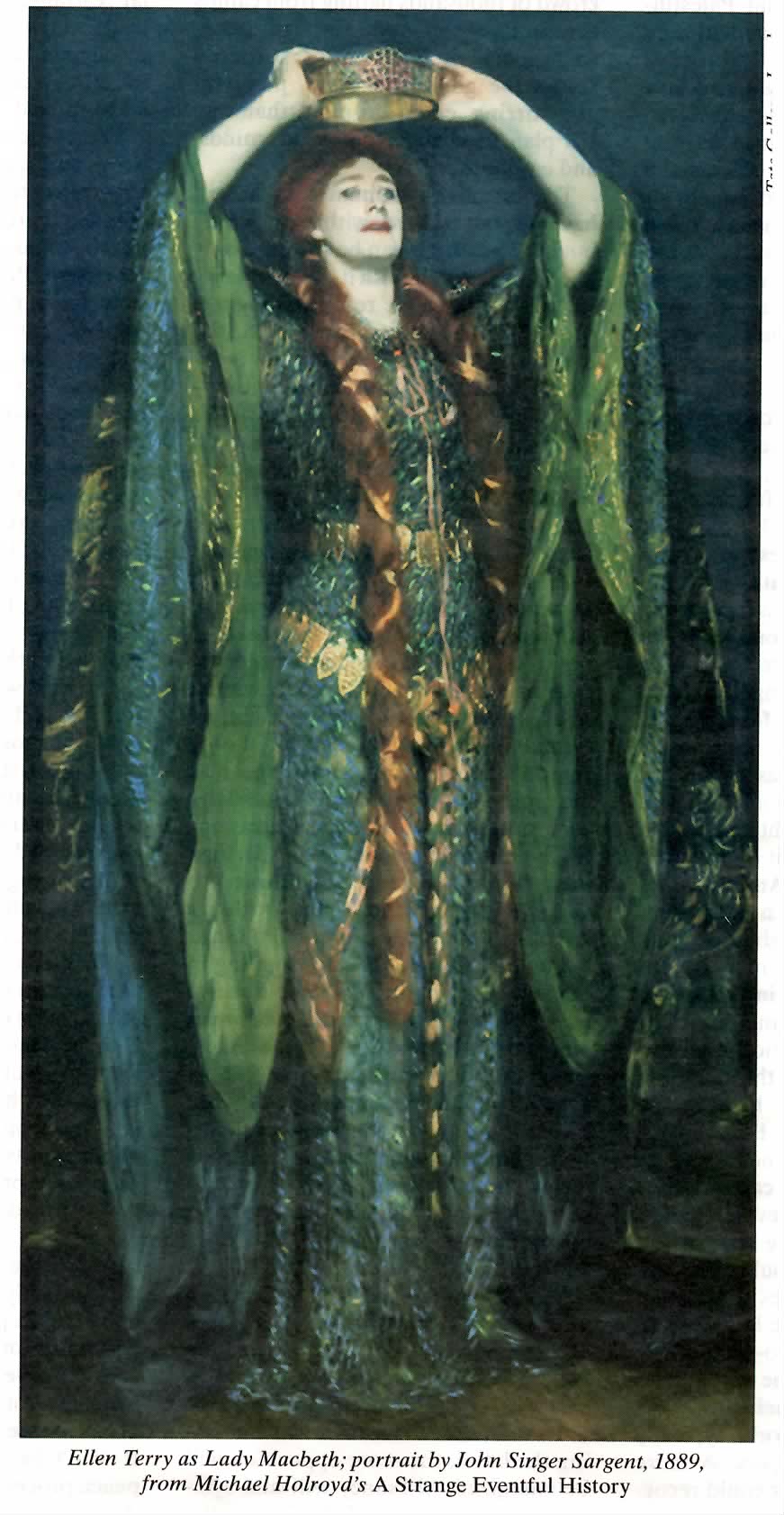
In a few weeks I will get the copy edit of THE SHADOW QUEEN. It will be entirely edited in Word. (With every novel the technology changes, in large part because I am such a slow writer.)
Then, after, I will plunge into writing the first draft of The Next Novel.
Juggling two historical periods is a bit of a challenge. I’m not having much luck making room on my shelves for new books.
The rest, in brief:
- The advance praise for THE SHADOW QUEEN—that is “blurbs”—has been fantastic.
- I’m reading Jane Austen in preparation for The Next Novel. More on dear Jane later.
- Both my husband and I are sick with colds only a few days in advance of a trip to New York. (Grrrr.)
- I began looking through the two boxes of the letters I wrote to my parents, found in their attic after my father died. I read through all of 1969: what a slice.
Lost in Memory Lane indeed.
SaveSave
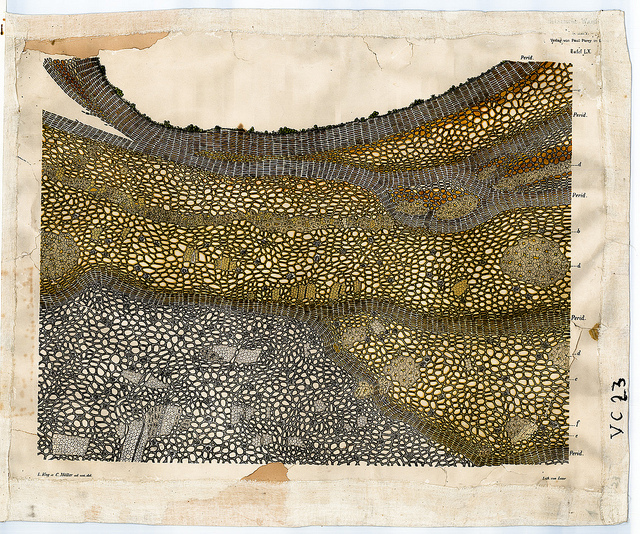
by Sandra Gulland | Dec 8, 2012 | Adventures of a Writing Life, The Shadow Queen, The Writing Process, Work in Process (WIP) |
I’ve been ill, slugging away at the “final” draft of The Next Novel in bed.
Yes: slugging. I find this final stage of taking a comma out and putting it back in (and more, I admit) somewhat tedious. I’m simply transferring my scribbled edits to a computer file, and I never (ever!) do this without thinking: could I contract this out?
The answer is: no. There are always mysteries that only I can solve. And, in truth, it is a pleasure to be so far along in the writing process to be obsessing about commas.
But I didn’t come here to complain, rather to share was looks like an inspiring blog: Brain Pickings, sent to me by a friend. Here’s a New York Times article on it. Cool. Tell me what you think.
And just so you know: I’m fully recovered. Every time I’m in the final stages of a novel I become convinced that I will die before it’s finished. Now, when that end-of-life conviction comes over me (and I wasn’t all that sick!), I think: Ah, almost there.
How do you respond in the final stages?
[Illustration: “Cork,” from the wonderful blog BibliOdyssey. Chosen for its many layers, so much like the process of building a novel.]

by Sandra Gulland | Oct 19, 2012 | Adventures of a Writing Life, The Shadow Queen |
“The Next Big Thing” is a “chain-blog” going around writers on the Net. I got tagged by historical novelist Stephanie Cowell, author of CLAUDE AND CAMILLE. You can see her own blog on The Next Big Thing here.
Ten Interview Questions for the Next Big Thing: What I’m working on now
What is your working title of your book?
IN THE SERVICE OF THE SHADOW QUEEN
Where did the idea come from for the book?
In researching MISTRESS OF THE SUN, I became intrigued by the life of Claude des Oeillets. She was the daughter of a theatrical star and confidential maid to the infamous Madame de Montespan, the Sun King’s “power mistress.” As well, she had a daughter by the King and dealings with Madame Voisin, the “witch” who was burned at the stake.
Basically, I was curious. Claude’s worlds were fascinating: the theater, the Court, the underground world of witchcraft. Too, she had an intimate view of Montespan, an endlessly fascinating and complex villainess.
What genre does your book fall under?
Historical fiction. I like to think I write literary historical fiction, but that is for readers to decide.
Which actors would you choose to play your characters in a movie rendition?
I’ve always thought Nicole Kidman would be fantastic as Madame de Montespan. As for the others … impossible for me to say. I so rarely watch movies.
What is the one-sentence synopsis of your book?
This is the hardest question you could ask a novelist; it is also the most important question to know how to answer. Here’s my attempt:
IN THE SERVICE OF THE SHADOW QUEEN is a historical novel set in 17th century France and based on the life of Claude des Oeillets, who leaves the disreputable make-believe world of the theater for a prestigious position at Court—only to discover that life at Court is itself an illusion, and one that disguises a horrifying sin.
Will your book be self-published or represented by an agency?
I have an agent, and the book will be published in the spring of 2014 by HarperCollins in Canada and Doubleday in the U.S.
How long did it take you to write the first draft of your manuscript?
One year. At least. And I’m working on the 8th and final draft.
What other books would you compare this story to within your genre?
Another difficult question! I’ve been told that my work is similar to that of Tracy Chevallier. A lovely thought, if true.
Who or what inspired you to write this book?
Curiosity about the world of 17th century French theater and my on-going fascination with Madame de Montespan.
I like to write about people who come into the Court world — or theatre world, or underground world — from outside, who view it as a traveller might. This allows us to see it through their eyes, the curious rituals, the details of daily life, the manners. These are the things most of interest to me.
What else about your book might pique the reader’s interest?
I did quite a bit of research into 17th century theater for this novel. I think readers will find it interesting to learn how theater companies were run, how the audiences behaved, how spectacles were performed, and how actors learned their lines … for starters.
In turn, I am tagging two gifted novelists and warmly invite you to visit their sites:
Caroline Leavitt, author of PICTURES OF YOU. You can read about her Next Big Thing here.
Lauren B. Davis, author of the Giller long-listed OUR DAILY BREAD
I’m supposed to tag five authors, in fact, but I’m traveling and it’s difficult. Caroline and Lauren will tag their fair share in turn, I know. If you haven’t read their work, I highly recommend that you do so. Also, be sure to read what their Next Big Thing is. It’s sure to be fantastic!
Message for tagged authors:
Rules of the Next Big Thing
***Use this format for your post
***Answer the ten questions about your current WIP (work in progress)
***Tag five other writers/bloggers and add their links so we can hop over and meet them.
***Include the link of who tagged you and this explanation for the people you have tagged.
***Be sure to line up your five people in advance.
Ten Interview Questions for the Next Big Thing:
What is your working title of your book?
Where did the idea come from for the book?
What genre does your book fall under?
Which actors would you choose to play your characters in a movie rendition?
What is the one-sentence synopsis of your book?
Will your book be self-published or represented by an agency?
How long did it take you to write the first draft of your manuscript?
What other books would you compare this story to within your genre?
Who or what inspired you to write this book?
What else about your book might pique the reader’s interest?

by Sandra Gulland | Jul 28, 2012 | Adventures of a Writing Life, Publication, The Shadow Queen, The Writing Process |
I’ve posted a few times of late about The Paradise Project, author Merilyn Simonds‘ limited-edition letterpress publication of short stories. In an age when publication is becoming more and more digital, I’m finding this hand-made centuries-old process fascinating.
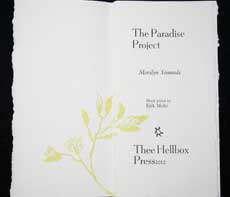
Merilyn has been blogging about the process. Her latest post, Gutenberg’s fingerprint, is especially evocative.
The studio is crowded today: all the people who worked onThe Paradise Project have gathered to see the final pages printed and put the press to bed. …
Mico looks at the press as he will one day look at the person he loves. “He let me run this thing when I was 14, and ever since, I’ve wanted to come back. It was a big mistake. Now I never want to leave.
Me neither.
On the news front, I’m awaiting the delivery of my edited last draft. I’m told that there are only about 50 small suggestions. (That’s nothing!) I’m also told I was described by an editor as “Queen of Revision.” I love that!
I’m considering changing my main character’s name from Claude (her historical name) to Claudine or Claudette. A number of readers get confused by what they consider a male name. I like the androgynous name and it suits Claude’s androgynous character, but I don’t like confusing readers (at least unintentionally). Your thoughts? Preferences? I’m leading toward Claudine.
I put off sending out my newsletter until later in August so that I could give more concrete information about the publication date, a possible title, the Josephine documentary as well as Sandra Gulland Ink publications.
Yes, there is a lot coming to a head next month!
Illustration at top is from Bibleodyssey.

by Sandra Gulland | Jun 30, 2012 | Baroque Explorations, On Research, The Sun Court Duet |
A reader asked about Louis XIV’s father:
Has anyone given serious consideration to the possibility that Henri d’Effiat, Marquis de Cinq-Mars, was the biological father of Louis XIV?
Richelieu went to his close friend D’Effiat specifically to bring his handsome 18-year-old son into the court. Cinq-Mars was given the title “master of the wardrobe” which provided him access to the royal bedroom.
One year later, Anne was with child. Cinq-Mars was accused of conspiring against the king (with Anne) and beheaded.
Cinq-Mars also was, coincidentally, “the Favorite” in the biblical sense with the gay Louis XIII.
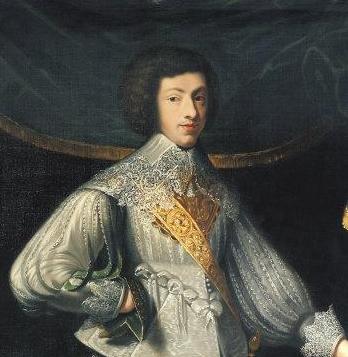
Henri de Cinq-Mars
My go-to-person for questions regarding Sun Court history is historian Gary McCollim. He generously provided this answer:
The answer to the question is simple:
No one ever accused Cinq-Mars of being Louis XIV’s father because of a simple matter of dates.
Louis XIV was born on 5 September 1638. Doctors had estimated in January that the queen was six weeks pregnant which meant that conception took place in late November 1637. The king and queen had been at Saint-Germain-en-Laye throughout the month of November and returned to Paris on 1 December. Doctors expected the child’s birth sometime between 23 to 28 August 1638.
Henri de Cinq-Mars was not appointed master of the king’s wardrobe until March 1638 when the queen was already pregnant.
While the appointment might have given Cinq-Mars access to the king’s bedroom, it did not give him access to the queen’s bedroom. Also, Anne of Austria for reason explained below was reluctant to join any conspiracy after the birth of her son. Some sources say she may even have been instrumental in exposing the Cinq-Mars conspiracy to Richelieu.
No serious historian today thinks that Louis XIV had any other father than Louis XIII.
Documentary evidence shows that Louis XIII and his wife, Anne of Austria, made up their differences in August 1637. Anne confessed to her participation of in some of the plots around the throne and of communicating with her brother the king of Spain. She promised to cease such behavior. Her near brush with disgrace persuaded her to abandon her plots and become the wife of her husband in fact and deed, so to speak. Louis XIII was convinced by Richelieu that the plotting would continue as long as he had no male heir. Thus, marital relations resumed between the two people in late summer 1637. The king had dedicated his kingdom to the Virgin Mary in February 1637 while praying for a male heir.
It has been fashionable among people today at a time when gay rights are in demand to think of Louis XIII as a homosexual and thus imply that he was somehow unable to father a child. We know that is not true. In fact, he was bisexual. He did have female favorites to whom he was loyal as well.
In any case, after the birth of Louis XIV the royal government put out the propaganda that his birth was miraculous, a result of prayers and supplications to God and the Virgin Mary.
Louis XIV was given the name Dieudonné (God-given).
There were many people who were surprised that the queen had gotten pregnant when she did, but no one at the time accused her of any improper behavior. There were people, such as the king’s brother Gaston and his cousins the Condes who had strong reasons to be wary of a surprise pregnancy as they were the heirs to the throne. Louis XIV’s birth pushed them further back in the line of succession.
Yet, Gaston and the Condes never made any accusations about Anne of Austira’s surprise pregnancy at the time or later during the Fronde.
A story emerged of the king Louis XIII being trapped in a terrible rainstorm on the night of 5 December 1637 and being forced to seek shelter in the Louvre where the only bed fit for the king was Anne of Austria’s.
Thus, implying that the conception took place that night. There is no proof that this story is true. Yet, it lives on in the popular imagination, plays have been written about it. In any case, Louis XIV grew up surrounded by this myth of his miraculous conception.
In the 1690s, however, when France was at war with all of Europe, his enemies the Dutch began to question the story and insinuated that Anne of Austria (who had died in 1666) had gotten pregnant from a man other than her husband.
One propaganda piece said the father was someone with the initials Le C. D. R. meaning Cardinal de Richelieu. Soon other candidates were accused of being the real father. Cardinal Mazarin was accused (he had died in 1661) but documentary evidence shows that he was in Italy from 1636 until 1640. Since the 1690s, historians have blamed other people, some famous like the Duke of Buckingham (died 1628) or the Duke of Beaufort (died 1669), and others less well known to be Louis XIV’s real father.
This whole story shows the power of propaganda to drive people’s imaginations without a shred of historical evidence.
In any case, Cinq-Mars has never been named as a possible father for the reasons I showed above.
Books that can shed light on this subject are:
Jean-Vincent Blanchard, Eminence (2011)
A. Lloyd Moote, Louis XIII, the Just (1989)
Ruth Kleinman, Anne of Austria, Queen of France (1985)
Claude Dulong, Anne d’Autriche (2000)
Jean-Christian Petitfils, Louis XIII (2008)
Gary is the author of: Louis XIV’s Assault of Privilege: Nicolas Desmaretz and the Tax on Wealth, published by the University of Rochester Press/Boydell & Brewer.
 His book discusses the difficult situation of royal finances at the end of the reign of Louis XIV, and how the king was forced to turn to Nicolas Desmaretz, a man who had been dismissed from the royal government in 1683 following the death of his uncle, the great Colbert.
His book discusses the difficult situation of royal finances at the end of the reign of Louis XIV, and how the king was forced to turn to Nicolas Desmaretz, a man who had been dismissed from the royal government in 1683 following the death of his uncle, the great Colbert.
Desmaretz had been critical of the royal government’s policies that increased the tax burden of the poorest elements of French society. He returned to the French government in 1703 as an assistant to the finance minister and became finance minister himself in February 1708. The book shows how Desmaretz and his staff were in contact with reformers and advocates of new policies. Out of this atmosphere of declining tax revenues, increasing defeats in the War of the Spanish Succession, and the refusal of France’s enemies to make a reasonable peace offer, Desmaretz decided to create a tax on the income produced by the ownership of property, in other words, a tax on the wealthiest elements of French society, to provide the funds necessary for France to survive the war and bargain for a reasonable peace.
After the war, Desmaretz was working to alleviate France’s debts in a way that could have changed the history of the eighteenth century except that Louis XIV died and Desmaretz was dismissed as the government turned to riskier schemes that boxed the royal government in for the rest of the eighteenth century leading to the Revolution.
About the author: Gary is a retired former employee of the US federal government He was educated at Muskingum College and received his doctorate in history from The Ohio State University studying under John C. Rule, a recognized expert on Louis XIV.
As always: thank you, Gary!
See also: The conception of Louis XIV.
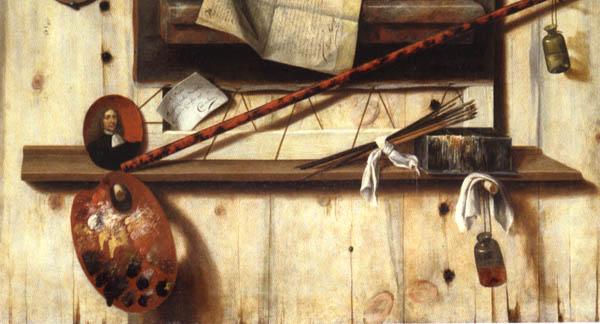
by Sandra Gulland | May 25, 2012 | Baroque Explorations, On Research, The Sun Court Duet |
In researching 17th century maternity wear, I came upon a treasure-trove of information on 17th century daily life in Holland compiled by art historian Kees Kaldenbach. The facts of daily life were deducted in part from the detailed inventories of the Vermeer household and paintings.
Fascinating! Enjoy …
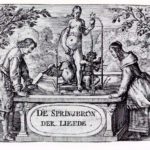
On courtship and making love
Childbirths, midwives, obstetricians
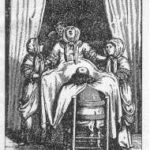
Maternity dress and trousseau
Children’s chair, potty chair
Baby child presented in a crisom
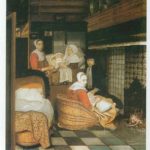
Feeding brest milk/mother’s milk
Vaginal syringe
Fire basket, fire holder

Mattress, bed, blanket. A bed was made of three layers:
- a flat mattress filled with bedstraw, horse hair or sea grass.
- a soft cover filled with feathers, down or “kapok” from silk-cotton trees. This is the layer a person would sleep on.
- sheets and blankets
Every day the sheets and blankets were folded so that the head-end and the foot-end did not touch. The pillows had to be shaken and aired for one hour, to dry the feathers, which tended to lump.
pillows (pillows, ear cushion, sit cushion, tapestry cushion — there were no chairs for the children. They were to use pillows when the adults used the chairs.); blanket,
bed cover: fascinating! The Vermeer household of 3 or 4 adults and 11 children had few blankets. People slept sitting up, two to a bedstead, propped up by pillows. The children slept in wheeled drawers which slid under the bed.
bedsheets, pillow cases, bed linen: 8 pairs of sheets were valued at 48 gilders — the equivalent of a workman’s wage for 24 to 48 days.
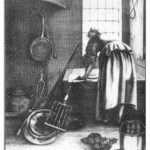
In the cooking kitchen
In the basement, or cellar
In the inner kitchen
Delft markets
Market bucket
Tables: fold-out table, pull-out table, round table, octagonal table, sideboard: This includes instructions on table manners. (“Do not propose to sing at the table oneself ; wait until one is invited repeatedly to do so and keep it short.”)
Trestle table
Foot stove: “One placed an earthenware container within the foot stove and filled it with glowing coals or charcoal. One then placed the feet on it. If a large dress was then lowered over it, or a chamber coat, it warmed both feet and legs.”

Tapestry table rug: “Only the most wealthy of Dutch households put Turkish rugs on the floor.”
Since I first posted this in 2012, the site moved and none of the links worked. I despaired! However, I emailed Drs Kees Kaldenbach and he kindly provided me with the new sites. Relief! This is one of the most illuminating accounts of daily life in the 17th century. For a historical novelist, it’s a gold-mine.











 His book discusses the difficult situation of royal finances at the end of the reign of Louis XIV, and how the king was forced to turn to Nicolas Desmaretz, a man who had been dismissed from the royal government in 1683 following the death of his uncle, the great Colbert.
His book discusses the difficult situation of royal finances at the end of the reign of Louis XIV, and how the king was forced to turn to Nicolas Desmaretz, a man who had been dismissed from the royal government in 1683 following the death of his uncle, the great Colbert.






